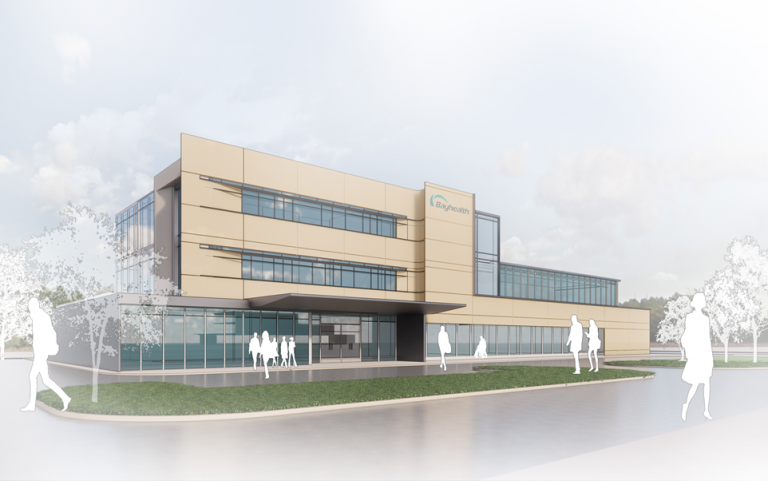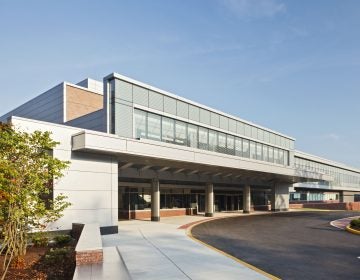Two Delaware hospitals seek approval for Sussex County emergency departments
Bayhealth and Beebe hospitals have made their case for stand-alone emergency departments in the Georgetown, Delaware, area

A rendering shows the proposed design for the Bayhealth emergency department. (Courtesy of Bayhealth)
Two Delaware hospitals are seeking approval from the state to build a stand-alone emergency department in the center of Sussex County.
Currently, there is none in the state’s southernmost county — and proponents say a new emergency facility in the area would shorten risky travel times.
A state recommendation committee does not agree, however, arguing that there are enough emergency service facilities in the surrounding area and that an additional one would create unnecessary health care costs.
Bayhealth proposes an 11,000-square-foot emergency department with 10 emergency room bays, estimated to cost $15.5 million to $17.2 million. The location east of Harbeson would be part of a larger facility that includes diagnostic imaging, primary-care and specialty services.
Beebe Healthcare proposes a 14,000-square-foot emergency department with triage and 21 beds for treatment in the heart of Georgetown, at an estimated cost of about $20 million.
The state Health Resources Board will make a decision on the proposals next month.
John Van Gorp, Bayhealth’s senior vice president of planning and business development, argued that a standalone emergency room is crucial because there is significant population growth to the west of Route 1 along the Route 9 corridor, as well as increased traffic — especially during peak beach season.
There also are limited emergency health services between Route 1 and Georgetown, he said. Currently, area residents must travel to hospitals in Seaford, Lewes and Milford.
Van Gorp said increasing the time an ambulance is on the road affects not only the patients’ drop off at the hospital but also the next patient waiting to be picked up by first responders.
“If you’re having a stroke or if you’re suffering from a drug overdose, those are major types of emergency services where time is of the essence, where you need to get treatment right away, and the longer it takes to get that emergency care the more detrimental the outcome will be,” he said.
The review committee does not believe population growth and traffic justify building a freestanding emergency department, according to its unfavorable recommendation last month.
In addition to the hospitals in Seaford, Lewes and Milford, there are urgent-care and walk-in centers in the proposed areas, such as LA Red, walk-in centers, and the Veterans Affairs center. In addition, Nanticoke Memorial Hospital in Seaford has expressed its opposition to the proposals, arguing it would be greatly affected.
Alex Sydnor, Beebe’s vice president for external affairs and chief strategy officer, argued that the available emergency services are located on the perimeter of the county — creating a “donut hole.” Patients have to travel about 16 miles to receive care, he said.
“As you can imagine for folks experiencing medical emergencies, one of the most important things is to get care quickly,” Sydnor said. “The longer the delay time there is for someone experiencing a medical emergency to receive care, the risk of complication or the decline in condition is greater.”
But the committee also argued that the proposals do not align with Gov. John Carney’s initiative to reduce emergency department visits and health care costs. Between October 2015 and September 2018, one-third of emergency department visits were non-emergent. Non-emergent visits also cost 10 times more for emergency departments than they do for urgent-care centers and primary-care physicians.
Bayhealth estimated its proposed facility would receive 5,000 to 7,000 emergency visits per year in the first few years, while Beebe projected its proposed facility would serve 24,000 patients a year.
Van Gorp said Bayhealth’s proposal is stronger than Beebe’s because the facility would be further from Nanticoke. He also said it would pose less of a threat to state initiatives to reduce health care costs and non-emergent visits: Six new primary-care physicians would provide patients with non-emergent issues an alternative to the emergency room.
Sydnor argued that Beebe already has seen a reduction in non-emergent cases in its Lewes facility as it has expanded walk-in centers and primary-care services. He said Bayhealth’s proposed site would overlap with existing services.
The Health Resources Board is expected to make a decision Aug. 15. The panel could follow the committee’s recommendation, approve just one proposal, or approve both of them.
Van Gorp said he thinks it will be an “uphill battle to overturn” the committee’s recommendation.
WHYY is your source for fact-based, in-depth journalism and information. As a nonprofit organization, we rely on financial support from readers like you. Please give today.




